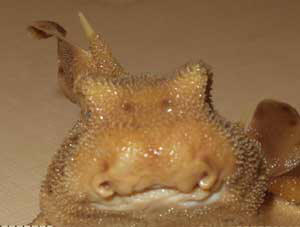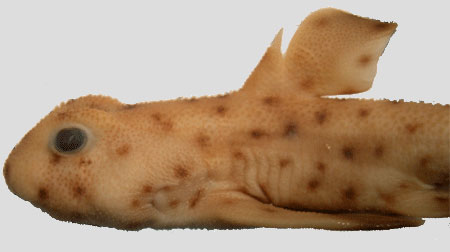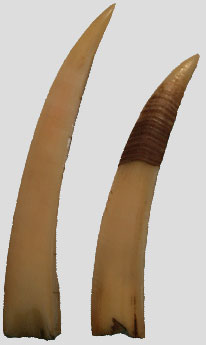Kelp Forests: Cathedrals in the Sea
Horn Shark
Small, commonplace, and harmless, the Horn Shark (Heterodontus francisci) is an underappreciated and little-studied kelp forest inhabitant. With its pig-like snout, bovine brow-ridges, and sedentary daytime habits, the Horn Shark hardly fits the popular image of a shark. Yet it is a full-fledged member of that fearsome group, marvelously adapted to its kelp forest environment, and a fascinating creature in its own, pint-sized way.
Just the Facts:
Size:
Reproduction:
Diet:
Habitat: Intertidal, Sandy Plains, Rocky Reefs, Kelp Forests Depth: intertidal - 490 ft (150 m) Distribution: Tropical Eastern Pacific |
Horn Sharks are bottom-dwelling animals that are typically inactive during the day. They typically spend daylight hours at one spot and individuals are often seen occupying the same caves or crevices day after day. Horn Sharks often rest with the head tucked under a rocky ledge. As a result, the unusually large dermal denticles above the brow-ridges and first dorsal fin spine of these sharks are often severely abraded. In contrast, Horn Sharks that prefer to rest on algal beds show relatively little denticle or fin spine wear. Juvenile Horn Sharks are often found in relatively shallow water, resting in feeding depressions made by Bat Rays (Myliobatis californica). Usually found as solitary individuals, Horn Sharks sometimes cluster together on the bottom, forming loose aggregations.
At night, cued by changes in ambient light intensity, Horn Sharks become quite active in search of prey. Experiments indicate that Horn Sharks repeatedly bite electrodes generating electrical fields having the same frequency as the muscle contractions of their prey. This response suggests that these sharks may rely on their electrosensory ampullae to locate prey. Adult Horn Sharks move onto the reef at dusk, searching a well-defined home range of about 10 760 square feet (1000 square metres) — or about the area of an Olympic-sized swimming pool. Searching the rocky substrate for prey is often accomplished using the broad, muscular pectoral and pelvic fins as limbs to clamber over the bottom. Swimming at night is sporadic and slow, suggesting that Horn Sharks are relatively inefficient swimmers. Individual Horn Sharks return to their favored daytime resting spots before dawn, digesting their evening meal in peace and quiet.
Predatory behavior of Horn Sharks is both fascinating and varied. Juveniles often invade the intertidal to feed on anemones, pouncing upon these cnidarians to nip off the tentacles before the hapless prey can retract them. The peculiar habit of juvenile Horn Sharks resting in Bat Ray excavations may also be feeding-related, granting them easy access to polychaete worms exposed but not eaten by the foraging rays. Not to be outdone,

Pig-like snout of a young Horn Shark, |
adult Horn Sharks" often take advantage of rich and easy feeding opportunities available under cover of darkness. At night, they have been observed hoovering up scores of small, diurnal damselfish known as Blacksmith (Chromis punctipinnis) as they doze in rocky crevices. Some adult Horn Sharks prefer to dine on sea urchins, crushing the spines and spherical tests with their molar-like rear teeth. Those that favor such prickly entrées are easy to spot, for the pigments of their prey often stain the teeth and dorsal spines a bright purple. Seasonally, adult Horn Sharks have been observed to gorge themselves into a stupor by scavenging upon expired carcasses of Market Squid (Loligo opalescens). After mating en masse, these squid — in finest operatic fashion — die by the tens of thousands under a silvery winter moon, providing an opportunists’ feast of astounding proportions.
|
|
Off Santa Catalina Island, California, adult Horn Sharks apparently undertake seasonal migrations. During summer months, they are typically found in relatively shallow inshore waters averaging about 18 feet (5.5 metres) deep. But during winter, Horn Sharks often retreat to offshore waters deeper than 120 feet (37 metres). This seasonal movement may be associated with Horn Shark reproduction. In the wild, Horn Shark mating occurs in December or January, which coincides well with this species’ seasonal movement offshore.
Horn Shark courtship, copulation, and egg-laying have been observed in captivity. The male Horn Shark chases the female until she accepts his advances, whereupon they both drop to the bottom. The male then grasps the female’s pectoral fin between his teeth and inserts a single clasper into her cloaca. Copulation lasts 30 to 40 minutes, after which the female spins over and over with her nose in the sand, as though having lost all sense of equilibrium. After about half an hour, she apparently recovers. One to two weeks later, egg-laying begins. A pair of auger-shaped egg cases is laid at 11 to 14-day intervals for four months.

Horn Shark egg case
In the wild, Horn Shark egg cases are laid between February to April. Females often deposit the auger-shaped egg cases under rocks or in crevices between them. Once they harden, the egg cases turn from amber to chocolate brown and are difficult for most predators to remove. However, large predatory snails — such as Kellet’s Whelk (Kelletia kelletii) — often break into Horn Shark egg cases using their rasp-like radula then suck out the yolk supply, thus killing the developing embryo. In addition, the Northern Elephant Seal (Mirounga angustirostris) is known to eat Horn Shark egg cases. It is unknown how significant are such predations in regulating Horn Shark populations.
Horn Sharks are named for the stout spine embedded in the leading edge of both dorsal fins. These spines are believed to be an anti-predator defense. Recently, a newborn Horn Shark was filmed off southern California venturing out over the sandy plains beyond the kelp forest. Suddenly, an unbelievably huge portion of the seabed seemed to explode upward as the bear-trap jaws of a Pacific Angel Shark (Squatina californica) protruded from the billowing silt to engulf the tiny Horn Shark. The silt had not settled before the Angel Shark opened its jaws and, with every appearance of abject disgust, gaped its toothy maw and forcefully regurgitated the little shark. The little shark then went on its way as though nothing much had happened. This particular Horn Shark may well have been saved by its prickly dorsal spines, which may have made it too difficult or irritating for the Angel Shark to swallow.

Juvenile Horn shark, with prominent spine
Horn Sharks do have other natural enemies, though. Northern Elephant Seals are known to eat newborns and subadults of this species, their dorsal spines apparently causing no gastronomic distress. One would think that sharks would be relatively safe from birds but, at Santa Catalina Island, Bald Eagles (Haliaeetus leucocephalus) have been observed snatching small Horn Sharks from the shallows, tearing them apart with their sharp beaks and talons, and eating them.
Scuba divers often harass Horn Sharks by handling them. Sometimes, as a ‘joke’, divers have been known to push the mouth of a Horn Shark against the trailing edge of one of their buddy’s swim fins, causing the little shark to clamp on, bulldog-like, for the remainder of the dive. Although, due to their small mouths and teeth, Horn Sharks are harmless to humans, they may chase and actually bite divers who have assaulted them. It’s hard not to admire that kind of scrappiness.


